Bitcoin has the potential to help unlock between 2 to 4 terawatts of clean, continuous and year-round baseload power — for one billion people — by harnessing the thermal energy of the oceans. The technology is Ocean Thermal Energy Conversion (OTEC), a 150-year old idea stymied by economies of scale, that turns Earth’s oceans into an enormous renewable solar battery.
It does this by combining warm tropical surface water and deep cold seawater to create a conventional heat engine. This simple idea is perfectly suited to be expanded to a planetary scale by Bitcoin’s unique appetite for purchasing and consuming stranded energy from the prototypes and pilot plants that will be required to prove it works. Furthermore, by harnessing virtually unlimited quantities of cold water for cooling co-located ASIC miners, OTEC may very well be the most efficient and most ecological way to mine Bitcoin.
The Conception Of OTEC
“There’s a powerful, obedient, swift, and effortless force that can be bent to any use and which reigns supreme aboard my vessel. It does everything. It lights me, it warms me, it’s the soul of my mechanical equipment. This force is electricity.”
–Jules Verne, “Twenty Thousand Leagues Under the Sea”
OTEC was conceived in 1881 when French physicist Jacques Arsene d’Arsonval proposed trapping the thermal energy stored in the ocean. He was inspired by Jules Verne’s novel “Twenty Thousand Leagues Under The Seas,” when Captain Nemo remarks how there is no shortage of energy that his ship, the Nautilus, could conceivably harness, such as “obtaining electricity through the diverging temperatures of different depths.”
D’Arsonval proposed using such diverging temperatures to power a heat engine, which converts heat into mechanical energy. D’Arsonval proposed a plant with a Rankine cycle, based on the work of William Rankine, a mid-19th century Scottish mechanical engineer who described an idealized thermodynamic cycle where mechanical work is extracted from a fluid as it moves between a heat source and heat sink. OTEC can be performed from the shore or interconnected to land from a distant oceanographic platform, well out of sight.
Over one billion people live within 100 kilometers of a tropical coast, where a 25ºC temperature difference can be found between warm surface seawater and cold deep seawater, at depths of one kilometer. This differential, or delta T, is perfect for OTEC. At room temperature, a working fluid such as ammonia will boil and evaporate. Reduce the temperature in a condenser bathed in deep cold seawater and the ammonia condenses back into a liquid. Together, the diverging temperatures produce the Rankine cycle that will power a turbine and generate electricity. The result is a clean, continuous base load power that runs year round and can provide free cooling for buildings, infrastructure or mining equipment. All you have to do is pump water to the surface and let physics do the work.
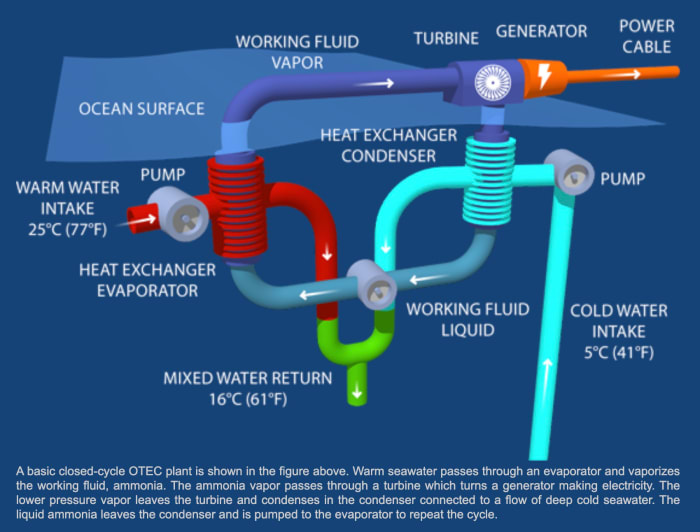
Image source: Makai Ocean Engineering
Other engineers would continue d’Arsonval’s legacy, such as Ben J. Campbell, who in 1913 predicted that the tropical oceans would prove an indefinitely large and inexhaustible storehouse of potential energy which could abundantly supply all the power needed by future man. But it would not be until 1930 that the first OTEC plant would be completed.
Georges Claude, a student of d’Arsonval’s — known as the “Edison of France” for his breakthroughs with neon lights and industrial gasses — would end up staking and losing his fortune in his floundering OTEC plant in Matanzas Bay, Cuba and a self-funded OTEC freighter to manufacture and sell ice to residents of Rio de Janeiro. Plagued by logistical issues, storms, mistakes and spiraling costs, the projects failed.
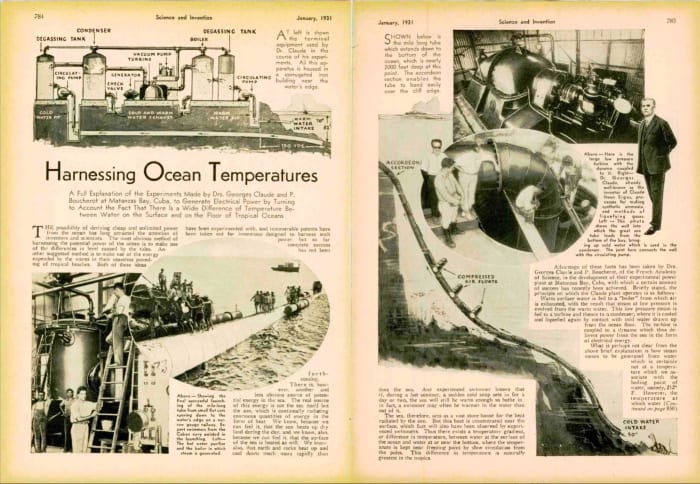
Image source: “Science and Invention,” January 1931
Claude had even considered extracting microscopic grains of gold from OTEC seawater, to increase his plant’s revenue. He could not have imagined that, almost a century later, oceanographers would be using seawater to extract a new kind of digital gold from computers.
Nikola Tesla considered ocean thermal energy to be extremely promising and proposed optimizations to Claude’s heat engine in order to improve the logistics and economics. The two engineers would each find that their individual attempts to harness Earth’s abundant energy would be foiled by economies of scale.
Claude’s losses made investors wary of OTEC. Within a few years, the discovery of nuclear fission had occurred and by 1944 prominent petroleum geologist Everette DeGolyer reported to the U.S. government that Middle East nations were sitting atop untold billions of barrels of oil. DeGolyer’s report to the State Department remarked, “The oil in this region is the greatest single prize in all history.” With that discovery, OTEC would be all but overlooked for decades to come and few governments were willing to invest much time or money into exploring or scaling the fledgling technology.
A New Hope For OTEC
“If only two percent of the power available in the ocean thermal difference were utilized we would have many times as much energy as the world now needs.”
–Bryn Beorse, University of California at Berkeley, 1977
There remains isolated interest in OTEC, especially in Hawaii. In 1979 the State of Hawaii, Lockheed Corporation, and two other companies partnered to create “Mini-OTEC,” the first successful closed-cycle, self-sustaining ocean thermal energy operation at sea. Set on a barge, the floating 50-kilowatt (kW) facility used a two-foot diameter, 2,150-foot-long polyethylene pipe for its cold-water intake.
Hawaii has since passed legislation in 2015 mandating 100% of the state’s energy be generated from renewable sources by 2045. Secluded in the warm waters of the Pacific Ocean, Hawaii has a unique power grid that is similar to Texas in that it is completely isolated and disconnected. As an added complexity, each island has its own stranded grid. No power is connected or shared between the individual islands, nor is there any political will to interconnect the islands. Ironically, Hawaii is physically surrounded by an enormous amount of potential energy, with little incentive to explore it.
Hawaii’s Big Island and its sparsely populated outer islands have a load of about 200 megawatts (MW), and should be able to easily meet the state’s mandate using conventional renewables, including geothermal. Oahu, Hawaii’s most populated island, has a more challenging situation.
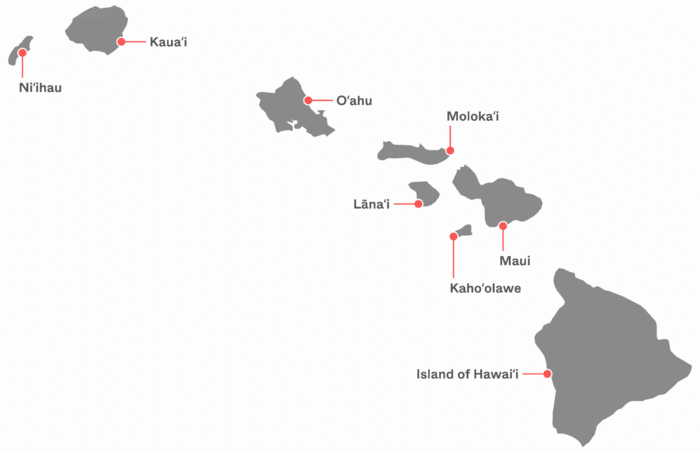
Image source: Only One
The Oahu Problem
Oahu is home to approximately 1 million of 1.4 million residents in the State of Hawaii and has a load of 2,000 MW, with almost no spare land to site new utilities. Conventional renewables on Oahu will either fall short or are untenable for a variety of reasons, according to Nathanial Harmon — an oceanographer and the founder and CEO of Blockchain Solutions Hawaii and OceanBit Energy, which merges Bitcoin mining and OTEC.
Harmon calculates that if you were to replace Oahu’s Kahe 600-MW fossil fuel plant with intermittent wind, you’d need an offshore wind farm the size of Oahu at a cost of approximately $19 billion. It would also need a utility-scale battery system and vast amounts of cabling and mooring. Such a farm would be devastating to Oahu’s coral reefs and it would interfere with whale breeding habitats.
For solar, Oahu would need to source enough panels and land area four times the size of its international airport if there were no space between the panels. Again, batteries would be required to produce constant power and the environmental destruction to situate the infrastructure would be considerable.
As for nuclear power, there is no realistic space to site a nuclear plant on Oahu. Even though nuclear power is a reliable, clean and safe form of energy production, there is no way to execute an evacuation plan for the island in the event of a tsunami, landslide or accident.
Wave technology, which remains unproven and lacks a reliable track record, would only meet roughly 17% of Oahu’s energy demands if the island were able to utilize all of its shoreline.
Even if you could find the land, displace landowners, violate the existing environment and rebuild Oahu’s grid to accommodate conventional renewables, it wouldn’t make fiscal sense. And again, each island has its own isolated grid and there is no political desire for interconnecting them.
At 30 cents per kilowatt hour, Hawaii already pays the highest energy costs in the nation. In 2020, Hawaiian Electric purchased approximately $6.75 million worth of curtailed energy, from producers, that was wasted. The bill for this waste is passed on to Hawaiian residents. Had the utility employed demand response Bitcoin mining, Harmon calculates the utility would have generated over $8 million in revenue. Interestingly, Hawaii may be one of the most profitable places to mine Bitcoin.
Each day, when the sun sets on Texas, thousands of solar-based ASIC miners wind down. Meanwhile, the sun is directly over Hawaii with no competition for solar mining for 2,000 miles East or West of the islands. Blocks are mined a little slower during this time, since there’s less mining happening elsewhere. As such, it can be more profitable to mine Bitcoin in Hawaii.
Harmon believes that OTEC is the only realistic option for Oahu to meet its renewable energy mandate. He consults for Makai Ocean Engineering, a company that has built the first grid-connected OTEC research facility in Kailua-Kona, on the Big Island. It’s a small, closed-cycle, 100-kilowatt plant that sits right on the shore.
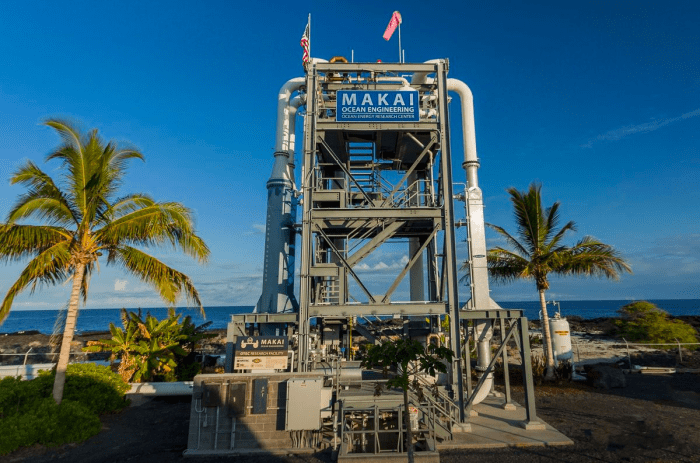
Image source: Makai Ocean Engineering
Yet, OTEC has not yet been proven to be feasible at scale. Its critics rightly point out its long history of physical and economic challenges. A 100-MW plant would need a cold water pipe about 35 feet in diameter, to reach depths of a kilometer and the pipe would need to reliably remain intact and connected through storms and strong currents, for decades. The economic challenges are equally daunting, but Harmon has a secret weapon: Bitcoin.
The Innovation Valley Of Death
To understand why Bitcoin and OTEC pair so well it is important to recognize both the economics that OTEC must overcome as well as the symbiotic relationship between ASIC miners and the ocean itself. Progress on OTEC is presently constrained by what is known as the Innovation Valley of Death. Pre-commercial OTEC plants are not commercially attractive but such facilities are needed to convince financiers that the risk is manageable considering the size of the potential market.
The small-scale test facilities, such as the 100-kilowatt Makai plant in Kona, produce electricity that is over $1 per kilowatt hour. There are no buyers for electricity at that price, but it’s still possible to get small-scale funding despite the unsellable electricity.
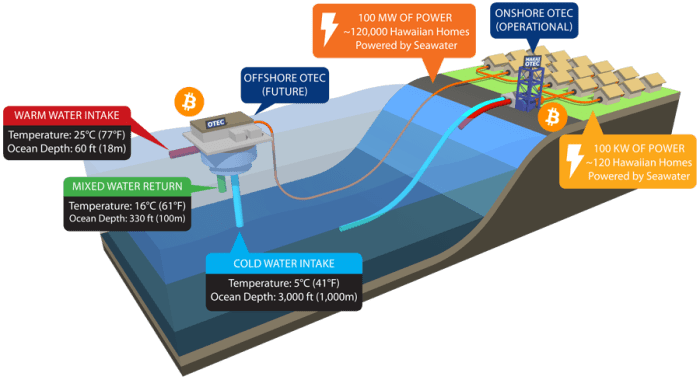
Image source: Makai Ocean Engineering
It is estimated that a large-scale, 100-to-400-MW OTEC plant would produce electricity in the range of 6 cents to 20 cents per kilowatt hour. However, engineers need to build a medium-scale (5-to-10-MW) test facility — proving it can reliably maintain its cold water intake pipes to produce continuous base load power for about two-and-a-half years — before a large-scale plant can be simulated and built. The problem is that an interconnected, medium-scale plant would cost about $200 million to $300 million and produce electricity in the range of 50 cents to $1 per kilowatt hour. Nobody on the grid will buy energy at that price. Anyone who funds a medium-scale OTEC plant would be taking a total loss on their sizable investment. The state of Hawaii can’t afford to take that kind of loss.
This conundrum gave Harmon an idea. What if the team optimized a medium-scale OTEC facility to mine Bitcoin?
A typical Bitcoin mining operation will spend considerable amounts of time, energy and money cooling their ASIC miners with air conditioning or liquid immersion cooling, and these costs eat into profitability. However, the main waste product of OTEC is a nearly-infinite and continuous supply of 5ºC cold water. Not only does OTEC produce free cooling, it provides a level of cooling that almost no one else in the mining industry has access to — enough to overclock mining rigs by 30% to 40%, according to Harmon. This allows OTEC to essentially achieve a power usage effectiveness (PUE) level of 1 — representing nearly perfect mining efficiency. It may very well be the most efficient way to mine Bitcoin.
If there is no buyer for the energy from a medium-scale test facility at 50 cents to $1 per kilowatt hour, then one doesn’t need to connect it to land — that’s a $40 million to $100 million savings by avoiding an offshore cable. If there is no need to connect it to land, then there is no need to obtain permits or moor the facility — that’s tens of millions of dollars in additional savings. And if there is no need to moor the facility, then it can be dynamically maneuvered, using its own discharge, and there’s no need to incur the exorbitant costs to hurricane-proof it. And if the facility can be maneuvered, the facility can “graze” and find the most optimal location for OTEC, with the warmest surface waters and greatest temperature differential, in order to maximize efficiency and avoid the Innovation Valley of Death. This just happens to be in the doldrums, a hot and windless region along the equator well known for stranding ships during the Age of Sail.
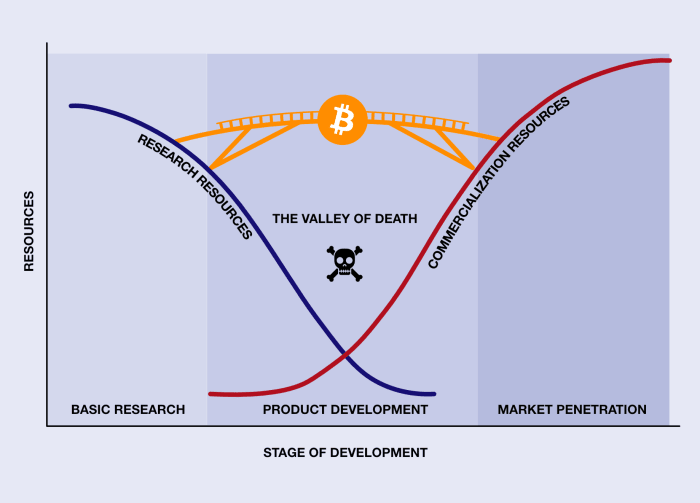
Image modified from Ocean Energy Systems
In an interview for this article, Harmon said OTEC’s energy generation efficiency scales with the square of the delta T. Theoretically, one can double the efficiency of OTEC with an additional 8ºC delta T. In other words, moving from Hawaii (which has a 20ºC annual mean delta T) to the equator (which has a 28ºC annual mean delta T) can turn a 5-MW facility into a 10-MW facility.
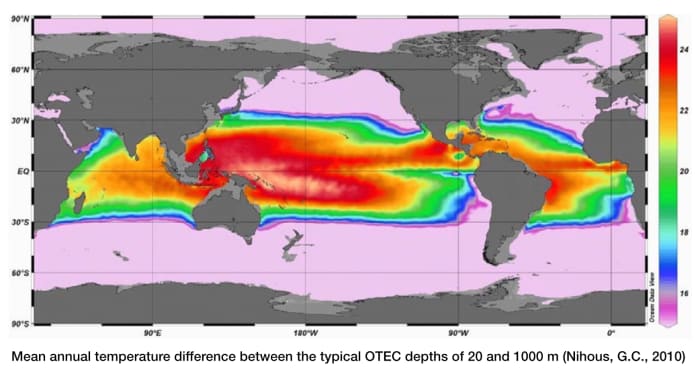
Image source: Ocean Energy Systems
With all of these optimizations and capital expenditure reductions, Harmon contends that his team can bring stranded, medium-scale OTEC down to 11 cents per kilowatt hour. Combined with free cooling and overclocked mining rigs, the test facility would be able to sell its stranded energy to a symbiotic and highly-optimized co-located buyer: Bitcoin mining.Image source: author
Harmon envisions that a medium-scale test facility, stranded on a barge in international waters and optimized to mine Bitcoin, will allow OTEC to overcome the Innovation Valley of Death for the first time in history.
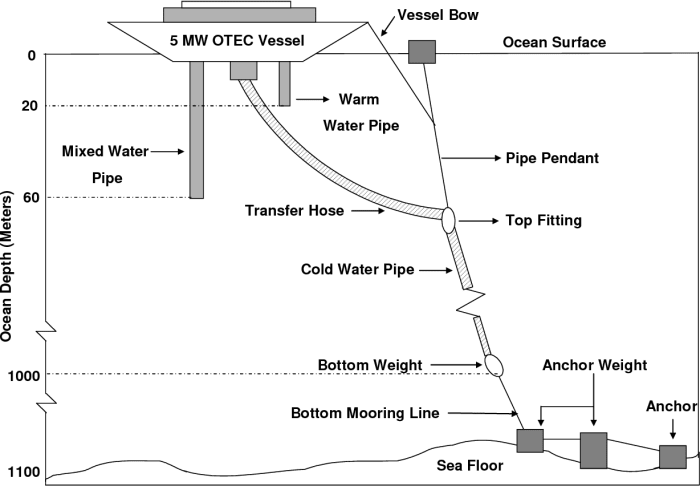
Image source: “OTEC Technology- A World Of Clean Energy And Water”
Energy Abundance And Bitcoin Flexible Load
Tropical locations that are well suited to large-scale OTEC could also have a lot of intermittent solar and wind and a lot of curtailment. Harmon envisions these regions would direct curtailment to their OTEC plants where the cooled and overclocked Bitcoin miners could be optimized to consume the excess energy and bring down the cost of large-scale OTEC.
A region that employed this architecture would enjoy cheap, clean and continuous base load power, with flexible load subsidized by Bitcoin mining revenue. By fostering energy abundance, OTEC can be used to power desalination plants to provide fresh drinking water for those regions while sustainably extracting raw minerals from seawater. More controversially, it might also make seabed mining of manganese nodules — trillions of dollars of geodes containing economic concentrations of minerals — profitable for the first time.
Tropical environments often have increased demand for air conditioning all year round. This typically raises energy costs and the high demand for energy often requires power from non-renewable sources. OTEC can reduce the need for energy-intensive air conditioning by providing sea water air conditioning (SWAC) to nearby buildings. Cold 5ºC water from OTEC is pumped through a heat exchanger to a closed loop chilled water system. The loop passes through various fan units which blow air over the chilled pipes to provide cool air into living spaces.
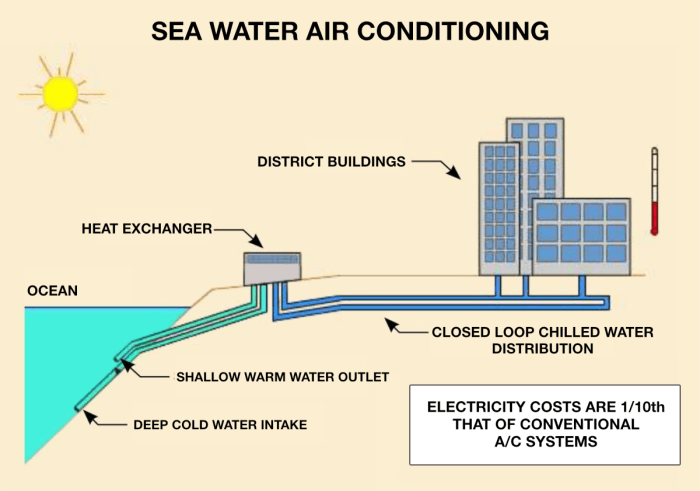
Image modified from The Brando
Hawaii’s Tradition Of Sustainable Natural Resources
Before contact with Westerners, the Kingdom of Hawaii had a long tradition of sustainability using the natural resources that were available to them. The native populations had a cultural tradition known as ahupua‘a — a watershed and common land division within streams and valleys. The ahupua‘a included the land from the mountains to the coast, and the coastal ocean extending out to and including the coral reef. The natives would plant taro in the highlands and divert streams into their fields which would carry nutrients down to rock walled fishpond estuaries at the ocean shore. It was in these estuaries that their favorite fish were cultivated in a mix of fresh nutrient-dense water and saltwater from the ocean.
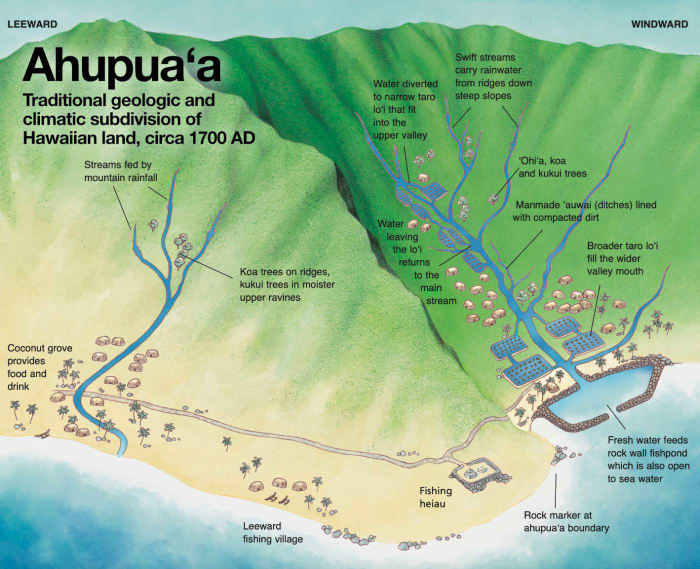
Image source: Water for Life, Hawaii Board of Water Supply
The pre-contact kingdom supported hundreds of thousands of people, completely isolated from the outside world for hundreds of years prior to Captain James Cook’s arrival in Hawaii, in 1778. Today, Hawaii imports approximately 85% of its food and 95% of its energy resources.
From Tradition To Modern Sustainability
The cold water that OTEC extracts from the deep ocean is rich in minerals and nutrients. Sea life on the ocean surface eventually becomes detritus and is constantly falling down into the depths of the ocean. Oceanic thermohaline circulation carries considerable quantities of detritus into the Pacific Ocean where the nutrient density is magnified. OTEC’s byproduct can not only be used for powering and cooling Bitcoin miners, its nutrients can be extracted for agriculture and aquaculture.
Water extracted by OTEC can be used for desalination or for producing green hydrogen fuel through energy-intensive electrolysis, all powered by OTEC. Whatever water isn’t used is discharged back to the ocean. Nutrients that are recirculated back into the seas increase the efficiency of shallow phytoplankton which can sequester carbon dioxide into the ocean depths as that sea life becomes falling detritus. However, the effects of this discharge needs to be studied at larger scales. It should be noted that unless artificial upwelling is maintained indefinitely, the effects would eventually reverse and possibly push temperatures even higher. This is why Harmon would much rather see those nutrients become carbon sinks on land and improve crop yields for humanity, where they would have a more lasting impact.
Applying electricity to seawater can create artificial reefs through a process known as seawater electrolysis, where calcium carbonate forms around a cathode, eventually coating the electrode with a material three times the strength of concrete. This accretion process was perfected by Wolf Hilbertz, who was inspired by the mid-19th century British scientist Michael Faraday, better known for inventing the DC battery. Faraday noticed a fluffy white precipitation when running electricity through water. When cultivated properly this precipitation creates calcium carbonate, the substance that coral and shells are composed of.
OTEC-powered seawater electrolysis could be used to generate self-repairing porous reefs that effectively dissipate wave energy to protect and regrow eroded beaches, shorelines and marine environments faster than sea levels can rise. These incredibly strong structures might even one day support new sustainable human habitats and create artificial archipelagoes powered with abundant OTEC electricity, fresh water, food and fuel.
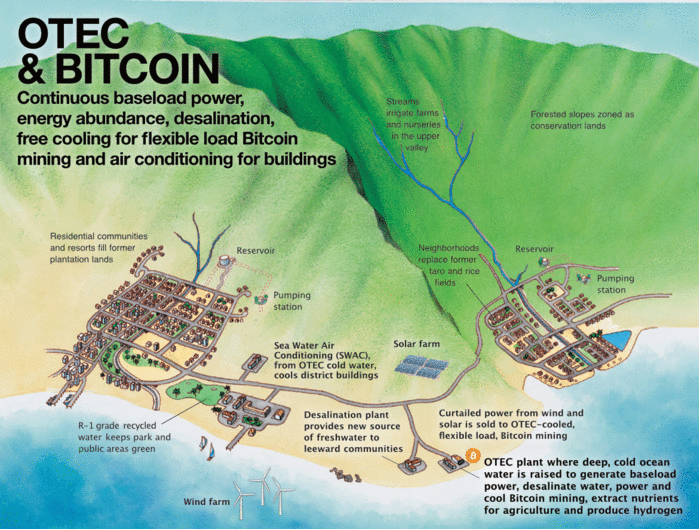
Image modified from Water for Life, Hawaii Board of Water Supply
Build, Test And Study
“If you have unlimited energy, you can solve any problem… OTEC is turning the surface of the ocean into a giant solar panel. There’s not enough lithium in the world to put batteries and solar panels to fuel the world’s energy resources. So, instead of that, you use the ocean which is already doing that.”
–Nathaniel Harmon, “Bitcoin, Energy, And The Environment”
There are potential environmental downsides to OTEC and studying those negative externalities is one of the main goals of the medium-scale test facility that Harmon and his team plan to build. The plants can be noisy and might affect sea life, so the noise attenuation must be studied. Another potential issue is the use of antifouling compounds used to keep pipes from corroding. And pumping too much nutrient-dense water onto the surface, without putting it to good use, can promote putrefaction. The solution is to release mixed water to a medium depth where it continues on in the detritus cycle. This still changes the trophic structure of the area surrounding the plant, which also needs to be studied.
While nutrient-dense water from OTEC can be used for agriculture, and for productive carbon sequestration on land, another potential application for the nutrient-dense water is aquaculture. Its “artificial upwelling” replicates the upwellings found in nature that are responsible for nurturing and supporting the world’s largest marine ecosystems, and the largest densities of life on the planet. Non-native species, such as abalone, trout, oysters, clams and cold-water sea animals, such as lobster and salmon, thrive in this nutrient-rich seawater and could be raised in tropical locations. This would reduce the need for distant shipping and energy-intensive refrigeration for tropical locations where harvested seafood often deteriorates quickly. In a twist of irony, the technology that was inspired by Verne’s fictional tale of seasteading could very well support permanent dwellings, research labs and Bitcoin citadels in international waters.
The first steps for Harmon and his team will be to refactor Makai’s Kailua-Kona 100-kW plant, on the Big Island, with S9 Bitcoin miners. The plant is too small to make money, but it will demonstrate the integrated cooling technology from OTEC. Next, the team wants to work on the medium-scale demonstration using a grazing containerized platform.
OTEC And Terraforming
Incredibly, OTEC can be used to enhance rainfall and moderate the high ambient summer temperatures in the tropics. A 100-MW power plant would be able to pump approximately 12 million gallons (44,400 metric tonnes) of 5ºC water to the surface — slightly more than the mass of the Bismarck-class battleship — every minute. Although more research is needed, in theory, if a number of large scale OTEC plants directed this upwelling to the surface in a region, it could affect the weather in potentially beneficial ways.
When the ocean surface is warm, this creates a lower pressure system which creates dry and warm oceanward winds. It is more preferable to have moist landward winds from the ocean which increase rainfall, reverse droughts, and promote more comfortable summer ambient temperatures (below 35°C) on land. Upwelling tens of billions of gallons of cold water toward the ocean surface would, in theory, have that effect — making tropical locations more temperate and better irrigated. Locations such as the Middle East, North East Africa, the Indian subcontinent and Australia could perhaps benefit from controlling their hot and dry summer seasons and erratic rainfall. These effects are self-limiting, since OTEC fails to operate if surface temperatures cool too much. However, stranded grazing OTEC barges mining Bitcoin can easily relocate to more optimal locations.
When Harmon was a graduate student at the University of Hawaii at Manoa — studying Marine Geology and Geochemistry — he proposed research on how Bitcoin could become the transport layer in Jeremey Rifkin’s book, “The Third Industrial Revolution.” Harmon’s proposal wasn’t well received. Professor Camilo Mora wasn’t interested. Dr. Michael J. Roberts, a professor of economics, emailed him saying his research was “seriously wrongheaded,” encouraged him to drop out of school to work for the Winklevoss twins, and read Paul Krugman for a proper critique of Bitcoin’s economics.
Harmon believes that he may have inadvertently inspired the thrice refuted Mora et al. 2018 opinion, in the scientific journal Nature, which erroneously claimed that Bitcoin could single-handedly drive up global temperatures by 2ºC. According to Harmon, the opinion was written by undergrads as part of a course project at the university, who may have caught wind of his research. Neither Camilo Mora, nor Katie Taladay, wrote it — they edited it for grammar, not content. To this day, the flawed paper is still cited by Bitcoin critics.
But what if Bitcoin and OTEC could more than just incentivize renewable energy. What if, together, they could moderate the climate and reduce extreme weather? Warm tropical waters along the equator notoriously generate tropical cyclones, typhoons and hurricanes that cause tens of billions of dollars of damage throughout the world each year. In theory, the severity of these storms could be lessened by artificially upwelling enormous quantities of cool water, funded by Bitcoin mining. As previously mentioned, a caveat is that ocean-based climate engineering, on a global scale, would likely need to be maintained indefinitely, otherwise the beneficial effects would soon reverse.
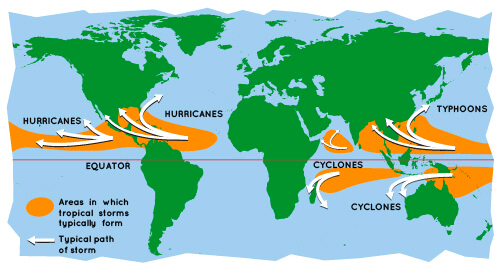
Image source: NASA
In a post to the Bitcointalk forum in 2010, Satoshi Nakamoto predicted that Bitcoin mining might gravitate towards the Earth’s poles, writing “Bitcoin generation should end up where it’s cheapest. Maybe that will be in cold climates where there’s electric heat, where it would be essentially free.”
Although Nakamoto perhaps did not consider that Bitcoin has the potential to draw enormous amounts of free energy from tropical oceans, OTEC is not technically limited to equatorial waters.
Energy As A Stranded Byproduct
“Power is synonymous with progress and civilization.”
Any temperature differential can be used to create energy. In the March 1930 issue of Scientific American, Dr. H. Barjot proposed using the heat differential between Arctic waters and air to produce energy during winter months when hydroelectric plants have reduced streamflow. Barjot envisioned using butane as a working fluid, which has a boiling point of -0.5°C. The fluid is condensed with blocks of ice-salt formed by frozen cryohydrate, a saturated saltwater ice made from brine, which is recirculated between a condenser back to an adjacent ice bed where it refreezes.
Assuming a realistic level of efficiency of 4%, Barjot calculated that the energy extracted from freezing one cubic meter of water in a Barjot OTEC plant would equal the energy generated by two gallons of petroleum. The waste product from a Barjot plant is ice.
Although modern engineers believe Barjot’s ideas were largely infeasible, they are not impossible. A Barjot plant could be located on polar region islands or on platforms attached to ice caps. Such stranded facilities could fund themselves with optimally-cooled Bitcoin mining to create artificial ice sheets or glaciers in Greenland or on Antarctica valleys located near the coast. The technology could even be used to terraform planets or moons in the very distant future.
The process of glacial grafting is not particularly difficult. During the 12th century, when news of Genghis Khan and advancing Mongols reached what is now northern Pakistan, villagers were said to have blocked the mountain passes by growing glaciers across them. The art of glacial grafting has been definitively practiced since at least the early 19th century, in the mountains of the Hindu Kush and Karakorum, for irrigation and to preserve access to fresh water.
Barjot’s proposal further illustrates how stranded temperature differentials can produce considerable quantities of energy and desirable byproducts such as nutrients, artificial reefs, aquaculture, desalinated water, minerals or even ice sheets. In a sense, one might think of stranded energy as the byproduct that can be readily exchanged for Bitcoin, to make the project a reality.
Pushing Humanity Forward
In 1964, Soviet astronomer Nikolai Kardashev proposed the Kardashev scale, a method of measuring a civilization’s level of technological advancement based on the amount of energy it is able to extract from its environment. Utilizing the free energy of a planet’s oceans is an imperative for a civilization’s advancement up this scale.
The possibilities of unlocking the thermal energy of the oceans is nearly limitless. While the innovators of a bygone era — including the likes of d’Arsonval, Claude, Campbell, Tesla and Barjot — were unable to see their ideas come to fruition, Bitcoin can help make their dreams of virtually-free renewable energy and abundance come to life. As governments around the world attempt to make sense of an open, inclusive and neutral global currency that monetizes energy, innovations in power generation will remain stifled without utilizing Bitcoin as a stranded energy buyer of last resort.
And yet, Bitcoin seems destined to tap the thermal energy of the oceans. Stranded OTEC Bitcoin mining, in international waters, would create a protective regulatory barrier from governments that would seek to stifle non-state money. With the power to seed seasteading citadels, OTEC could allow humans to sustainably and independently thrive in isolated waters — beyond the reach of governments. The more governments fight Bitcoin, the more Bitcoin will be drawn to energy-abundant international waters.
The ability for Bitcoin to unlock energy abundance embodies what Brandon Quittem describes in his essay “Bitcoin Is A Pioneer Species,” where Bitcoin mimics biological systems that colonize inhospitable environments and liberate the potential energy in raw elements for more advanced species to utilize and flourish.
Prove It Works
For all the imagination and hope of an energy-abundant future that OTEC could unleash, one must be realistic. There are still engineering challenges with medium-scale 100 MW OTEC that must be solved. However, compared to what has been accomplished by the offshore oil and gas industry, the obstacles are not impossible to overcome. The issue at present is that the challenges are keeping humanity from scaling the technology from 10 MW to 100 MW scale.
Before Bitcoin, a 10 MW OTEC plant was too expensive and the Innovation Valley of Death too wide. There are environmental issues as well, but nothing at the scale of the issues from fossil fuel extraction or combustion. Comprehensive study is needed as part of the scaling process.
Still, OTEC has had more failures than successes in its long history of futuristic dreaming for a brighter future. The question remains, will it work? The good news is that we don’t have to trust oceanographers and engineers making extraordinary claims about OTEC, or any energy technology for that matter. Instead, Bitcoin is a test lab for scaling new forms of energy production. Bitcoin mining rigs and their public wallet addresses will prove to investors, and the general public, if test facilities are able to perform the work they claim. In this light, proof of work is just another term for “prove it works.”
Bitcoin doesn’t care if OTEC works or not. If an OTEC pilot plant produces the energy that is promised, the team that built it will be rewarded. Proven on a public ledger, the plant will have a symbiotic co-located buyer for stranded energy and can secure the funding needed to scale up the operation. If not, the experiment fails with no reward. Bitcoin mining rigs plug right into any power source, in any remote location, ready to pay for its energy with digital gold. Bitcoin will be the final judge and jury as to whether or not OTEC scales or fails.
Therein lies the beauty of Bitcoin mining and proof of work, an energy-hungry digital bearer asset that paradoxically unlocks human flourishing and energy abundance. Claude was never able to extract enough microscopic flecks of gold from seawater or sell enough ice to fund his stranded OTEC projects. But, he might have succeeded if he had a reliable co-located buyer of energy. By stranding energy on inaccessible shores and distant platforms humanity can begin the process of harnessing power in ways never before possible.
For the first time, the opportunity to economically harness planetary power is within our grasp. Thanks to Bitcoin, the human spirit of innovation remains strong. The journey won’t be easy, and there’s much work to be done. And through it all, Bitcoin will be ready, willing and able to guide humanity on that endeavor to a future of energy abundance, prosperity and freedom.
This is a guest post by Level39. Opinions expressed are entirely their own and do not necessarily reflect those of BTC Inc or Bitcoin Magazine.



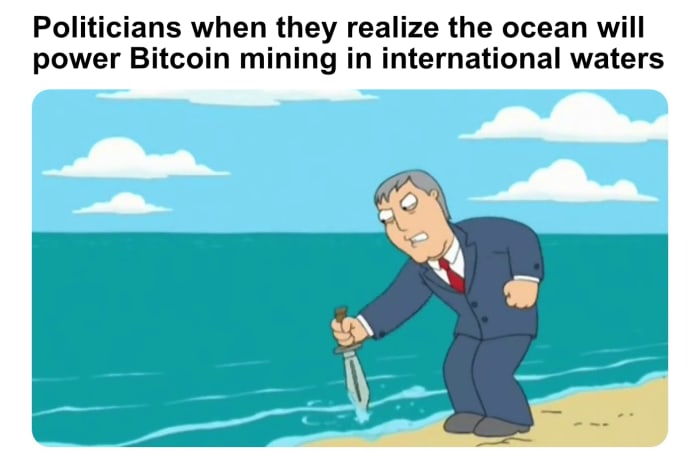
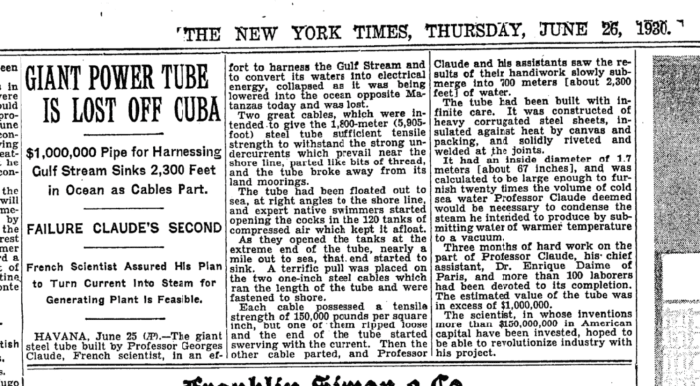
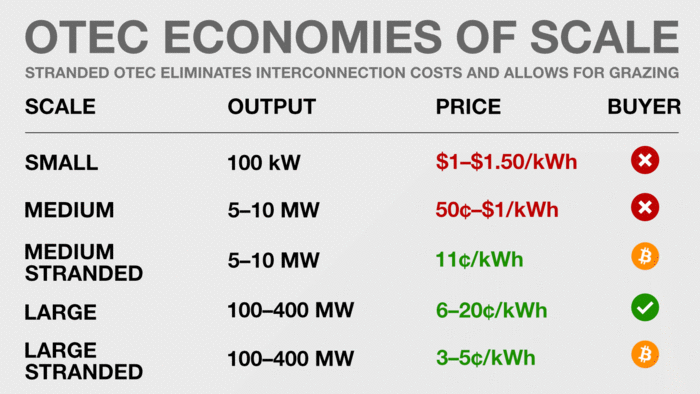
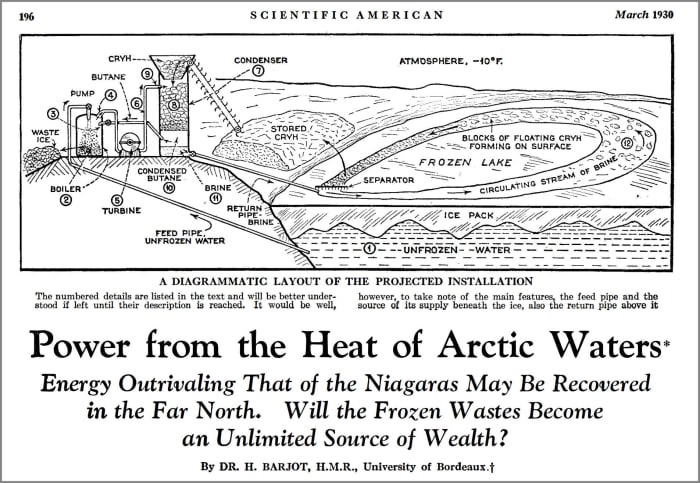
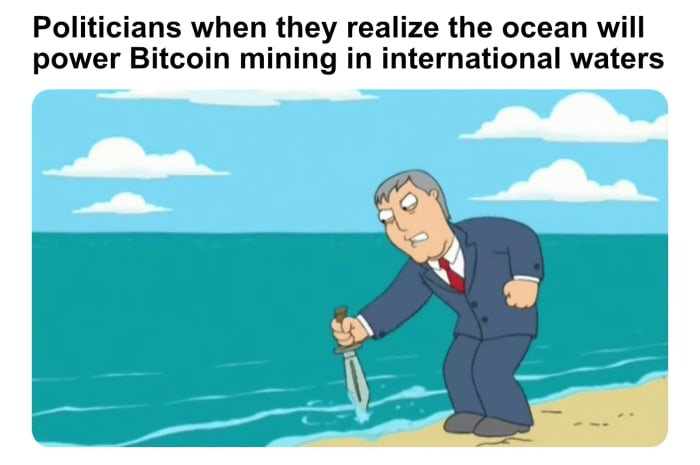


















Comments (No)